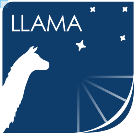
The Large Latin American Millimeter Array (LLAMA) is a joint scientific and technological project of Argentina and Brazil whose goal is to install and to operate an observing facility capable of performing observations of the Universe at millimeter and sub-millimeter wavelengths. The project is being financed by Secretaría de Articulación Científico Tecnológica do Ministerio de Educación, Cultura, Ciencia y Tecnología of Argentina and Fundação de Amparo a Pesquisa do Estado de São Paulo (FAPESP) from Brazil. At first, a 12m diameter antenna will be offered, but it is intended to install a second antenna in the future.
LLAMA will be located in the Puna de Atacama in the northwestern part of Argentina at a place whose terrestrial coordinates are 66o 28' 29.4" W and -24º 11' 31.4" S. The site, locally known as Alto Chorrillos, is located at an altitude of 4820 meters above sea level (masl), about 180 km south-east of the Atacama Large Millimeter/Submillimeter Array observatory (ALMA). In addition, the site selected for LLAMA has atmospheric conditions similar to those of ALMA. An area of 400 hectares was allocated for this project by the Government of the province of Salta, at a distance of 20 km (straight line) from the town of San Antonio de los Cobres (SAC, 3800 masl). The headquarters is being built in SAC with laboratories, offices and accommodations to provide the necessary infrastructure for remote antenna operation.
The antenna is being built by Vertex AntennenTechnik GmbH and was based on the design developed for ALMA. The main reflector has a diameter of 12m and, at the time of the acceptance, the surface of the antenna should have an accuracy of 25 μm rms (the objective for operations is to reach 15 μm, using holographic measurements) and pointing accuracy of at least 2 arc seconds. The antenna will have Cassegrain focus and two Nasmyth cabins, thus presenting potential to receive a wide variety of peripheral instruments.
The radio telescope will initially be equipped with ALMA-like receivers and in particular the so-called bands 5 (157 - 212 GHz) and 9 (602 – 720 GHz). Initially the instrument will operate as a single-dish telescope but in the near future it will be used as part of Very Long Base Interferometry networks (VLBI). These networks may include ALMA, the Atacama Pathfinder Experiment (APEX), and the Atacama Submillimeter Telescope Experiment (ASTE). In this way, an increase in the angular resolution of at least a factor 10 of the currently achieved by ALMA would be possible. It is expected that LLAMA will also be part of the Event Horizon Telescope (EHT) consortium.

View of Alto Chorrillos, region where LLAMA will be installed.